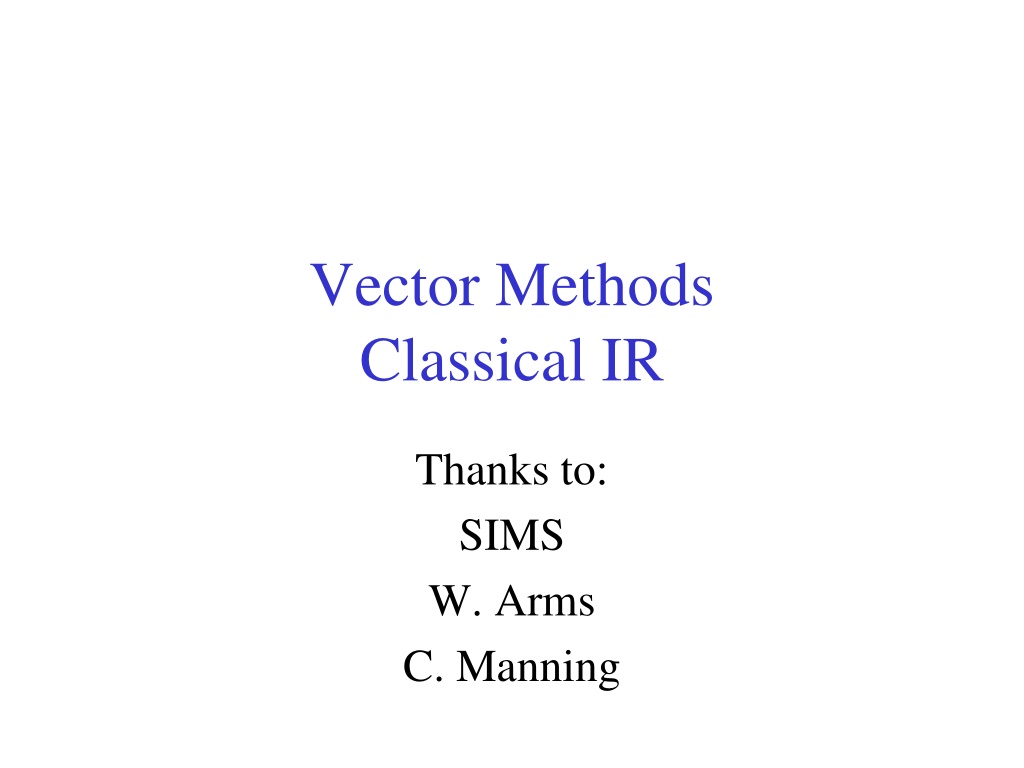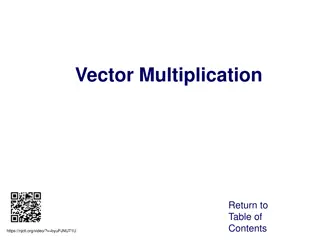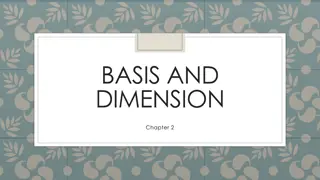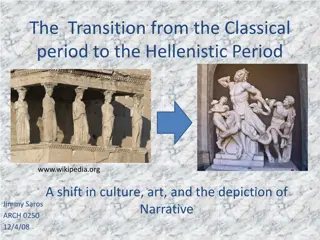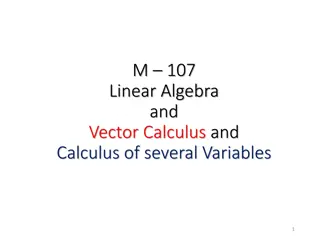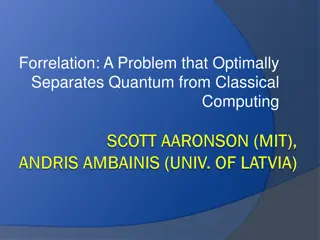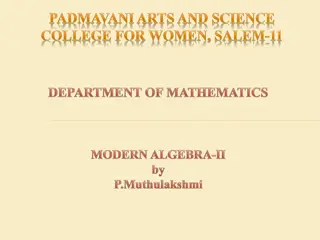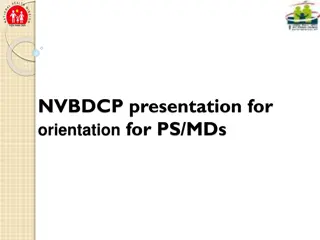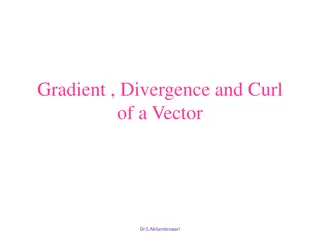Vector Methods Classical IR
This content covers classical information retrieval methods with a focus on vector techniques. It explores IR evaluation, precision, recall, and measures of similarity. The text delves into tokenization, web crawling, and document representations using embeddings. It also discusses query engines, indexing subsystems, and search systems in the context of online and offline processing.
Download Presentation

Please find below an Image/Link to download the presentation.
The content on the website is provided AS IS for your information and personal use only. It may not be sold, licensed, or shared on other websites without obtaining consent from the author.If you encounter any issues during the download, it is possible that the publisher has removed the file from their server.
You are allowed to download the files provided on this website for personal or commercial use, subject to the condition that they are used lawfully. All files are the property of their respective owners.
The content on the website is provided AS IS for your information and personal use only. It may not be sold, licensed, or shared on other websites without obtaining consent from the author.
E N D
Presentation Transcript
Vector Methods Classical IR Thanks to: SIMS W. Arms C. Manning
What we have covered What is IR Evaluation Precision Recall, F measure Tokenization and properties of text Web crawling Robots.txt
Today Vector methods for documents and queries Text embeddings Bag of words Measures of similarity vector scoring Similarity scoring as ranking Query models Queries as small documents
Motivation How to enable computers to process words Need to use words (tokens) How do we do this? Vector methods for words vectorization word embeddings Same process for understanding words in Natural language processing AI and machine learning Recommender systems Computational advertising
Vectorization (embeddings) Document representation Used for document Encoding Similarity Ranking Importance In AI and machine learning, this is called representations
Query Engine Index Interface Indexer Users Crawler Web A Typical Web Search Engine
Users Query Engine Index Interface Online Indexer Crawler Offline Web Online vs Offline processing
Representation Query Engine Index Interface Indexer Users Crawler Web A Typical Web Search Engine
Indexing Subsystem documents Documents assign document IDs text document numbers and *field numbers break into tokens tokens stop list* non-stoplist tokens stemming* *Indicates optional operation. stemmed terms term weighting* terms with weights Index database
Search Subsystem queryparse query query tokens ranked document set stop list* non-stoplist tokens ranking* stemming* stemmed terms Boolean operations* retrieved document set *Indicates optional operation. Index database relevant document set
Terms vs tokens Terms are what results after tokenization and linguistic processing. Examples knowledge -> knowledg The -> the Removal of stop words
Matching/Ranking of Textual Documents Major Categories of Methods 1. Exact matching (Boolean) 2. Ranking by similarity to query (vector space model) 3. Ranking by probabilistic methods (Indri) 4. Ranking of matches by importance of documents (PageRank) 5. Combination methods What happens in major search engines (Googlerank)
Vector representation of documents and queries Why do this? Represents a large space for documents Compare Documents Documents with queries Retrieve and rank documents with regards to a specific query - Enables methods of similarity All search engines do this and some text processing methods. Gerald Salton 75 SMART system
Boolean queries Document is relevant to a query if the query itself is in the document. Query blue and red brings back all documents with blue and red in them Document is either relevant or not relevant to the query. What about relevance ranking partial relevance. Vector model deals with this.
Matching - similarity Matching will be based on document similarity Define methods of similarity for documents and queries Use similarity for document scoring or ranking
Similarity (Scoring) Measures and Relevance Retrieve the most similar documents to a query Equate similarity to relevance Most similar are the most relevant This measure is one of text similarity The matching of text or words
Similarity Ranking Methods Index database Documents Query Mechanism for determining the similarity of the query to the document. Set of documents ranked by how similar they are to the query
Term Similarity: Example Problem: Given two text documents, how similar are they? [Methods that measure similarity do not assume exact matches.] Example (assume tokens converted to terms) Here are three documents. How similar are they? d1 d2 d3 ant ant bee dog bee dog hog dog ant dog cat gnu dog eel fox Documents can be any length from one word to thousands. A query is a special type of document.
Bag of words view of a document Tokens are extracted from text and thrown into a bag without order and labeled by document. Mary is Thus the doc John is quicker than Mary. is indistinguishable from the doc Mary is quicker than John. Tokens are then in an array based on some order. John than quicker is john mary quicker than
All words into an array with weights on how often they appear
Bag of words models Often used in NLP https://www.youtube.com/watch?v=QCk1i DQlaWA
Term Similarity: Basic Concept Two documents are similar if they contain some of the same terms. Possible measures of similarity might take into consideration: (a) The lengths of the documents (b) The number of terms in common (c) Whether the terms are common or unusual (d) How many times each term appears
TERM VECTOR SPACE Term vector space (token embedding) n-dimensional space, where n is the number of different terms/tokens used to index a set of documents. Vector Document i, di, represented by a vector. Its magnitude in dimension j is wij, where: wij > 0 if term j occurs in document i wij = 0 otherwise wij is the weight of term j in document i.
A Document Represented in a 3-Dimensional Term Vector Space t3 d1 t13 t2 t12 t11 t1
Basic Method: Incidence Matrix (Binary Weighting) document text d1 d2 d3 terms ant bee ant ant bee dog bee dog hog dog ant dogant bee dog hog cat gnu dog eel fox cat dog eel fox gnu ant bee cat dog eel fox gnu hog 3 vectors in 8-dimensional term vector space d1 1 1 d2 1 1 1 1 d3 1 1 1 1 1 Weights: tij = 1 if document i contains term j and zero otherwise
Basic Vector Space Methods: Similarity between 2 documents t3 The similarity between two documents is a function of the angle between their vectors in the term vector space. d1 d2 t2 t1
Vector Space Revision x = (x1, x2, x3, ..., xn) is a vector in an n-dimensional vector space Length of x is given by (extension of Pythagoras's theorem) |x|2= x12 + x22 + x32 + ... + xn2 |x| = ( x12 + x22 + x32 + ... + xn2 )1/2 If x1 and x2 are vectors: Inner product (or dot product) is given by x1.x2 = x11x21 + x12x22 +x13x23 + ... + x1nx2n Cosine of the angle between the vectors x1 and x2: x1.x2 |x1| |x2| cos ( ) =
Document similarity (Vector Space Scoring) d = (w1, w2,w3, ..., wn) is a vector in an n-dimensional vector space Length of d is given by (extension of Pythagoras's theorem) |d|2= w12 + w22 + w32 + ... + wn2 |d| = (w12 + w22 + w32 + ... + wn2 )1/2 If d1 and d2 are document vectors: Inner product (or dot product) is given by d1.d2 = w11w21 + w12w22 +w13w23 + ... + w1nw2n Cosine angle between the docs d1 and d2 determines doc similarity d1.d2 |d1| |d2| cos ( ) = cos ( ) = 1; documents exactly the same; = 0, totally different
Example 1 No Weighting ant bee cat dog eel fox gnu hog length d1 1 1 2 d2 1 1 1 1 4 d3 1 1 1 1 1 5 Ex: length d1 = (12+12)1/2
Example 1 (continued) ant bee cat dog eel fox gnu hog length d1 1 1 2 d2 1 1 1 1 4 d3 1 1 1 1 1 5 d1 1 d2 0.71 d3 0 Similarity of d1 d2 d3 documents in 0.71 1 0.22 example: 0 0.22 1 Use cosine measure
Weighting Methods: tf and idf Term frequency (tf) A term that appears several times in a document is weighted more heavily than a term that appears only once. Inverse document frequency (idf) A term that occurs in a few documents is likely to be a better discriminator that a term that appears in most or all documents.
Digression: terminology WARNING: In a lot of IR literature, frequency is used to mean count Thus term frequency in IR literature is used to mean number of occurrences in a doc Not divided by document length (which would actually make it a frequency) We will conform to this misnomer In saying term frequency we mean the number of occurrences of a term in a document.
Example 2 Weighting by Term Frequency (tf) document text d1 ant ant bee d2 dog bee dog hog dog ant dogant bee dog hog d3 cat gnu dog eel fox terms ant bee cat dog eel fox gnu ant bee cat dog eel fox gnu hog length d1 2 1 5 d2 1 1 4 1 19 d3 1 1 1 1 1 5 Weights: tij = frequency that term j occurs in document i
Vector Space Calculation for Example 1 x = (x1, x2, x3, ..., xn) is a vector in an n-dimensional vector space Length of x is given by (extension of Pythagoras's theorem) |d2|2 = 12 + 12 + 42 + 12 |d2| = ( 1+1+16+1)1/2 = (19)1/2 ; |d1| = ( 22+1)1/2 = (5)1/2 If d1 and d2 are vectors: Inner product (or dot product) is given by d1.d2 = 2*1 + 1*1 +0*4 + 0*1 = 3 Cosine of the angle between the vectors d1 and d2: d1.d2 |d1||d2| cos ( ) = = = 3/ ( 5* 19) = 0.31
Example 2 (continued) Similarity of documents in example: d1 1 d2 0.31 d3 0 d1 d2 d3 0.31 1 0.41 0 0.41 1 Similarity depends upon the weights given to the terms. [Note differences in results from Example 1.]
Summary: Vector Similarity Computation with Weights Documents in a collection are assigned terms from a set of n terms The term vector space W is defined as: if term k does not occur in document di, wik = 0 if term k occurs in document di, wik is greater than zero (wik is called the weight of term k in document di) Similarity between di and dj is defined as: wikwjk |di| |dj| Where di and dj are the corresponding weighted term vectors and |di| is the length of the document vectordi n k=1 cos(di, dj) =
Summary: Vector Similarity Computation with Weights Query as a little documents Inner product (or dot product) between documents d1.d2 = w11w21 + w12w22 +w13w23 + ... + w1nw2n Inner product (or dot product) is between a document and query d1.q1 = w11wq11 + w12wq12 +w13wq13 + ... + w1nwq1n where wqij is the weight of the jth term of the ith query
Approaches to Weighting Boolean information retrieval: Weight of term k in document di: w(i, k) = 1 if term k occurs in document di w(i, k) = 0 otherwise General weighting methods Weight of term k in document di: 0 < w(i, k) <= 1 if term k occurs in document di w(i, k) = 0 otherwise
Simple Uses of Vector Similarity in Information Retrieval Threshold For query q, retrieve all documents with similarity above a threshold, e.g., similarity > 0.50. Ranking For query q, return the n most similar documents ranked in order of similarity. [This is the standard practice.]
Simple Example of Ranking with a Query (Weighting by Term Frequency) query q document text d1 d2 d3 ant dog terms ant bee ant ant bee dog bee dog hog dog ant dogant bee dog hog cat gnu dog eel fox cat dog eel fox gnu ant bee cat dog eel fox gnu hog length q 1 d1 2 1 5 d2 1 1 4 1 19 d3 1 1 1 1 1 5 1 2
Calculate Scoring or Ranking Similarity of query to documents in example: d1 d2 d3 q2/ 10 5/ 38 1/ 10 0.63 0.81 0.32 If the query q is searched against this document set, the ranked results are: SERP d2, d1, d3 d2 d1 d3
Contrast of Ranking with Matching With matching, a document either matches a query exactly or not at all Encourages short queries Requires precise choice of index terms Requires precise formulation of queries (professional training) With retrieval using similarity measures, similarities range from 0 to 1 for all documents Encourages long queries, to have as many dimensions as possible Benefits from large numbers of index terms Benefits from queries with many terms, not all of which need match the document
Document Vectors as Points on a Surface Normalize all document vectors to be of length 1 Then the ends of the vectors all lie on a surface with unit radius For similar documents, we can represent parts of this surface as a flat region Similar document are represented as points that are close together on this surface
Results of a Search x x hits from search x x x x x x documents found by search query
Relevance Feedback (Concept) hits from original search x x o x x o o x documents identified as non-relevant o documents identified as relevant original query reformulated query
Document Clustering (Concept) x x xx x x x x x x x x x x x x x x x Document clusters are a form of automatic classification. A document may be in several clusters.
Best Choice of Weights? query q document text d1 d2 d3 ant dog terms ant bee ant ant bee dog bee dog hog dog ant dogant bee dog hog cat gnu dog eel fox cat dog eel fox gnu ant bee cat dog eel fox gnu hog What weights lead to the best information retrieval? q ? d1? ? d2? ? ? ? d3? ? ? ? ? ?
Methods for Selecting Weights Empirical Test a large number of possible weighting schemes with actual data. (Salton, et al.) Model based Develop a mathematical model of word distribution and derive weighting scheme theoretically. (Probabilistic model of information retrieval.)
Weighting Term Frequency (tf) Suppose term j appears fij times in document i. What weighting should be given to a term j? Term Frequency: Concept A term that appears many times within a document is likely to be more important than a term that appears only once.
Term Frequency: Free-text Document Length of document Simple method is to use wij as the term frequency. ...but, in free-text documents, terms are likely to appear more often in long documents. Therefore wij should be scaled by some variable related to document length.
